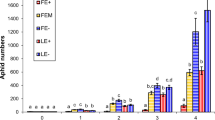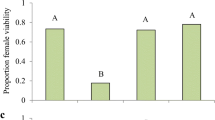Abstract
Endophytic fungi in cool-season grass species produce herbivore-toxic alkaloids, which are assumed to harm higher trophic levels along food chains. Previous studies have shown fitness disadvantages for higher trophic levels that feed on aphids that were exclusively reared on perennial ryegrass (Lolium perenne) infected with the endophytic fungus Neotyphodium lolii. However, it is unknown whether the alkaloids produced by the fungus-grass association can be assimilated by plant sap-sucking insects like aphids. Using an ultra high performance liquid chromatography method combined with mass spectrometry, we provide the first evidence that the alkaloids peramine and lolitrem B are present in aphids (Rhopalosiphum padi) and in aphid predators when the aphids are reared on endophyte-infected grass. We conclude that alkaloids can enter the plant sap of the grass and are responsible for longer pupal stages of the ladybird Harmonia axyridis and for fitness disadvantages of aphids and their predators as shown in previous studies.

Similar content being viewed by others
References
Ball OJP, Barker GM, Prestidge RA, Lauren DR (1997) Distribution and accumulation of the alkaloid peramine in Neotyphodium lolii – infected perennial ryegrass. J Chem Ecol 23:1419–1434
Blackman RL, Eastop VF (2000) Aphids on the world’s crops: an identification and information guide, 2nd edn. John Wiley & Sons Ltd., Chichester
Cheplick GP, Faeth SH (2009) Ecology and evolution of the grass-endophyte symbiosis. Oxford Univ Press, Oxford UK
De Sassi C, Müller CB, Krauss J (2006) Fungal plant endosymbionts alter life history and reproductive success of aphid predators. Proc R Soc B 273:1301–1306
Faeth SH, Saari S (2012) Fungal grass endophytes and arthropod communities: lessons from plant defence theory and multitrophic interactions. Fungal Ecol 5:364–371
Härri SA, Krauss J, Müller CB (2008a) Fungal endosymbionts of plants reduce lifespan of an aphid secondary parasitoid and influence host selection. Proc R Soc B 275:2627–2632
Härri SA, Krauss J, Müller CB (2008b) Trophic cascades initiated by fungal plant endosymbionts impair reproductive performance of parasitoids in the second generation. Oecologia 157:399–407
Hartley SE, Gange AC (2009) Impacts of plant symbiotic fungi on insect herbivores: Mutualism in a multitrophic context. Annu Rev Entomol 54:323–342
Keogh RG, Tapper BA, Fletcher RH (1996) Distributions of the fungal endophyte Acremonium lolii, and of the alkaloids Lolitrem B and Peramine, within perennial ryegrass. New Zeal J Agr Res 39:121–127
Koch RL (2003) The multicoloured Asian lady beetle, Harmonia axyridis: a review of its biology, uses in biological control and non-target impacts. J Insect Sci 3:32–47
Kos M, Broekgaarden C, Kabouw P, Lenferink KO, Poelman EH, Vet LEM, Dicke M, Van Loon JJA (2011) Relative importance of plant-mediated bottom-up and top-down forces on herbivore abundance on Brassica oleracea. Funct Ecol 25:113–1124
Müller CB, Krauss J (2005) Symbiosis between grasses and asexual fungal endophytes. Curr Opin Plant Biol 8:450–456
Newton E, Bullock JM, Hodgson D (2009) Bottom-up effects of glucosinolate variation on aphid colony dynamics in wild cabbage populations. Ecol Entomol 34:614–623
Osawa N (1993) Population field studies of the aphidophagous ladybird beetle Harmonia axyridis (Coleoptera: Coccinellidae): Life tables and key factor analysis. Res Popul Ecol 35:335–348
Pasteels JM (2007) Chemical defense, offence and alliance in ant-aphids-ladybirds relationships. Pop Ecol 49:5–14
Rasmussen S, Pearson AJ, Bassett S, Christensen MJ, Hume DE, Johnson LJ, Johnson RD, Simpson WR, Stacke C, Voisey CR, Xue H, Newman JA (2006) High nitrogen supply and carbohydrate content reduce fungal endophyte and alkaloid concentration in Lolium perenne. New Phytol 173:787–797
Rudgers JA, Clay K (2008) An invasive plant-fungal mutualism reduces arthropod diversity. Ecol Lett 11:831–840
Saikkonen K, Saari S, Helander M (2010) Defensive mutualism between plants and endophytic fungi. Fungal Divers 41:101–113
Saikkonen K, Gundel PE, Helander M (2013) Chemical ecology mediated by fungal endophytes in grasses. J Chem Ecol 39:962–968
Schardl CL, Leuchtmann A, Spiering MJ (2004) Symbioses of grasses with seedborne fungal endophytes. Annu Rev Plant Biol 55:315–340
Siegel MR, Bush LP (1996) Devensive chemicals in grass-fungal endophyte associations. Recent Adv Phytochem 30:81–118
Tanaka A, Takemoto D, Chujo T, Scott B (2012) Fungal endophytes of grasses. Curr Opin Plant Biol 15:462–468
Acknowledgments
We thank two anonymous reviewers for helpful comments on the manuscript, Jutta Winkler and Matthias Jäger for plant and insect rearing, and the DFG project “Insect timing” SFB 1047 for funding. We thank all the members of the Department of Animal Ecology and Tropical Biology at the University of Würzburg for advice on our manuscript.
Author information
Authors and Affiliations
Corresponding author
Electronic supplementary material
Below is the link to the electronic supplementary material.
ESM 1
(DOCX 26 kb)
Rights and permissions
About this article
Cite this article
Fuchs, B., Krischke, M., Mueller, M.J. et al. Peramine and Lolitrem B from Endophyte-Grass Associations Cascade Up the Food Chain. J Chem Ecol 39, 1385–1389 (2013). https://doi.org/10.1007/s10886-013-0364-2
Received:
Revised:
Accepted:
Published:
Issue Date:
DOI: https://doi.org/10.1007/s10886-013-0364-2




